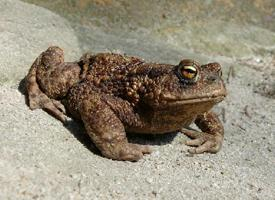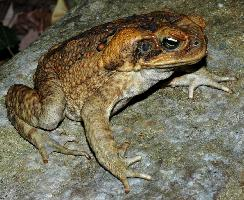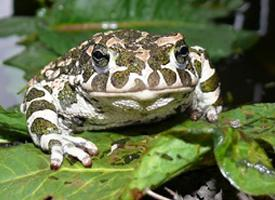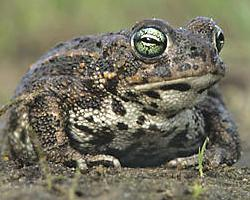
Váhy a míry
| Délka | od 63 do 120 mm |
|---|
Biologická data
| Délka života | od 4 do 9 let |
|---|
Stav ohrožení
| Ohrožen |
Popis zvířete
The Common toad, scientifically known as Bufo bufo, is a fascinating amphibian that is widespread across Europe and parts of Asia. This species plays a vital role in the balance of many ecosystems, serving as both predator and prey in its natural habitat. The Common toad is a creature of habit, known for its remarkable homing instinct, often returning to the same breeding sites year after year.Physical Characteristics:
The Common toad is easily identifiable by its warty skin, which ranges in color from dark brown to olive green, and sometimes even shades of grey. These warts secrete a mild toxin that deters many predators, providing the toad with a natural defense mechanism. Adult toads can vary significantly in size, but they typically range from 6 to 13 centimeters in length. Males are generally smaller than females and can be distinguished by their darker throats, which are visible during the breeding season. The Common toad has a robust, squat body and short legs, which makes it more adept at walking than hopping. Its eyes are striking, with horizontal, slit-like pupils, and it possesses parotoid glands behind the eyes, which are another source of its toxic secretions.
Habitat and Distribution:
Bufo bufo has a wide distribution, thriving in a variety of habitats including forests, gardens, meadows, and even arid landscapes, provided there is access to a body of water for breeding. These toads are predominantly nocturnal, spending the day hidden under logs, stones, or leaf litter to avoid predators and conserve moisture. Despite their widespread presence, they are rarely seen, due to their nocturnal habits and excellent camouflage.
Diet:
The diet of the Common toad consists mainly of invertebrates, including insects, spiders, slugs, and worms. They are sit-and-wait predators, relying on their excellent camouflage to ambush prey. Their sticky tongues are adept at catching fast-moving prey with remarkable accuracy.
Reproduction:
The breeding season for Common toads occurs in the spring, when temperatures begin to rise. Males migrate to ponds, lakes, or slow-moving rivers, often returning to the same breeding sites year after year. Here, they compete for females, who lay thousands of eggs in long, gelatinous strings attached to vegetation in the water. Tadpoles emerge after about three weeks, embarking on a perilous journey to adulthood. They undergo metamorphosis, losing their tails and developing legs, and by late summer, they are fully transformed into terrestrial juvenile toads.
Conservation Status:
Currently, the Common toad is classified as Least Concern by the International Union for Conservation of Nature (IUCN), indicating that it is not at immediate risk of extinction. However, like many amphibians, it faces threats from habitat destruction, pollution, climate change, and disease. Conservation efforts are crucial to ensuring the long-term survival of this species, emphasizing the importance of protecting their breeding and terrestrial habitats.
In conclusion, the Common toad is a resilient and adaptable amphibian with a wide range across Europe and parts of Asia. Its unique physical characteristics, fascinating life cycle, and role in ecosystem dynamics make it an important species in its natural habitat. Despite its current conservation status, ongoing efforts to protect and preserve natural habitats are essential to its continued survival and the health of ecosystems worldwide.
Podobná zvířata
Nové fotografie zvířat
Top 10 zvířat
- Dolphin gull (Leucophaeus scoresbii)
- Japanese macaque (Macaca fuscata)
- Stone loach (Barbatula barbatula)
- Greek tortoise (Testudo graeca)
- Diana monkey (Cercopithecus diana)
- Galápagos tortoise (Geochelone nigra complex)
- Russian tortoise (Testudo horsfieldii)
- Moustached guenon (Cercopithecus cephus)
- Galápagos penguin (Spheniscus mendiculus)
- Common flying dragon (Draco volans)


